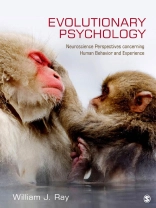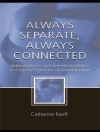Many books in evolutionary psychology emphasize just a small part of the total picture. William J. Ray′s book gives students a clear understanding of how current psychological knowledge of human behavior and experience draws from a variety of perspectives. It begins with an understanding of evolution and the close connection between organisms and their environment, focusing on how the environment and genes can influence humans and the cultures of which they are a part. Using current research in social processes, decision making, and brain imaging, Ray explores how humans solve certain life problems in the same way that many non-human species do. He also highlights human abilities not seen in other species, including our ability to use language, develop culture, and create writings and art that can influence other humans thousands of years later. Written in a clear, easy-to-understand manner, the book emphasizes developmental processes and family relationships, sexual and social relationships, and emotionality and language. It concludes with an examination of health and disease, psychopathology, and culture, all seen through an evolutionary lens.
Tabella dei contenuti
PART I: Introduction and Background
Chapter 1: Introduction to an evolutionary perspective
Chapter 2: What is evolution?
Chapter 3: Evolution and genetics
PART II: Basic human function and process
Chapter 4: Evolution of brain and function
Chapter 5: Developmental processes
Chapter 6: Emotionality
Chapter 7: Language
Chapter 8: Sex and gender
Chapter 9: Sexual selection
Chapter 10: Kin and family relationships
Chapter 11: Social relations
Chapter 12: Making social decisions
PART III: Applications
Chapter 13: Health and disease
Chapter 14: Psychopathology
Chapter 15: Culture
Circa l’autore
William J. Ray is an Emeritus Professor of Psychology at Pennsylvania State University. He received his Ph D from Vanderbilt University and was a Fellow in Medical Psychology at the University of California Medical Center in San Francisco. He received his undergraduate degree from Eckerd College, where he learned about the value of primary sources and the need to integrate information from a number of perspectives. As part of his clinical training, he has worked in a number of mental hospitals and clinics across the country, where he developed an appreciation of the experiences of those with mental disorders. In his career, he has served as a visiting professor and researcher at the University of Hawaii, Münster University, University of Rome, Tübingen University, and Konstanz University. At Penn State, he was the Director of the SCAN (Specialization in Cognitive and Affective Neuroscience) program and was previously the Director of the Clinical Psychology Program. His research has focused on approaching clinical questions from a neuroscience perspective. He has used psychophysiological and brain imaging techniques such as EEG, MEG, DTI, and f MRI to study emotionality, psychopathology, and individual differences. These studies can be found in his numerous articles, book chapters, and books. His work has been published in such journals as Science, Proceedings of the National Academy of Sciences, Journal of Neuroscience, Psychophysiology, Physiological Reviews, Journal of Personality and Social Psychology, Developmental Psychology, Journal of Abnormal Psychology, Cognitive Brain Research, Biological Psychology, Neuro Image, and Clinical Neurophysiology. This work has been funded by both national and international agencies including NIH, NIMH, NASA, NATO, and the DAAD. In addition to research, teaching has been an important part of his career. His textbooks include Abnormal Psychology, Methods Toward a Psychology of Behavior and Experience, Psychophysiological Methods (with Robert Stern & Karen Quigley), and Evolutionary Psychology: Neuroscience Perspectives Concerning Human Behavior and Experience.












